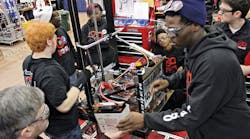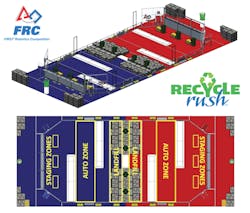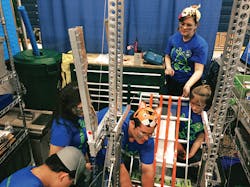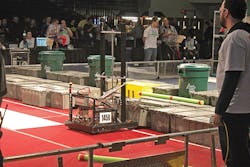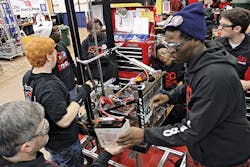Everything You Missed from the 2015 FIRST Robotics Competition
This file type includes high resolution graphics and schematics when applicable.
Class, homework, popularity, and sports are only a few things students are dealing with, but how do you fit building a robot into this? The mission of an annual, robotics competition, For Inspiration and Recognition of Science and Technology (FIRST), is to show students that science and technology can be fun, rewarding, and a proven path to success. Created in 1989, FIRST targets grades K through 12 with the Junior FIRST Lego League (Jr. FLL), the FIRST Lego League (FLL), the FIRST Tech Challenge (FTC), and the FIRST Robotics Competition (FRC).
The Jr. FLL is for ages 6-9, where students explore real-world problems and present solutions with a poster and a model. Students often use Legos to build their models. The Jr. FLL doesn’t have a competition, and projects can vary from building windmills to potato peelers. The FLL is for students 9-14 to build autonomous robots from Lego kits so they can solve challenges, and compete with one another. The FTC covers grades 7-12 and has students building more sophisticated robots with programing to accomplish harder challenges in competition. This competition can include Legos, Tetrix, and Matrix components. This is also the only competition that allows raw materials to be used in building the robot, however, it is carefully regulated. Finally, the FRC is the most complex competition for grades 9-12. Students start with a kit of parts (KOP) that can vary. Allied Electronics, only one of the competition’s sponsors, donated 26 different products including diodes, LEDs, resistors, capacitors, fuses, and more, totaling 434,000 pieces in all. Students also have access to FIRST choice, a website for teams to select mechanical parts for their design.
FRC KOP Manager Kate Pilotte said, “It’s a constant debate about how much innovation and responsibility we want to offer. There is a ‘gas grill’ approach, where we essentially give students everything with instructions. Then, there is the ‘Apollo 13’ model where they are given a set of parts, a goal to accomplish, and the students have to figure out how to obtain those results.”
Watch "Team Dragon Robotics STEM Students Build Robot for FIRST Robotics Competition," courtesy of Engineering TV:
Building a Robot
Up until 2009, the FRC kits were identical. Today, there are three parts to the kits: the kickoff kit, the virtual kit, and FIRST Choice. The kickoff kits consist of items that are packed into totes and distributed to teams at local kickoff sites. There are two variations of the kickoff kit: one set of items goes to all teams and a second container goes to first-year and rookie teams. This rookie kit contains extra parts to help new teams not be overwhelmed.
The kickoff kit also includes a pre-assembled driver base kit from which the robot is constructed. This year about 2,300 driver base kits were shipped. Each kit provides over 10,000 possible configurations. Teams also can opt out of this kit to receive a voucher to purchase parts to build their own driver base.
The virtual kit contains software downloads and products donated by suppliers. Teams are able to decide which software is needed for their specific design, and they can then use vouchers to order that software online.
Finally, the FIRST Choice kit is another voucher system that allows teams to order parts online on a first-come, first-served basis. This year, 61 suppliers donated parts to the competition and the first round yielded 2,244 orders.
All robots are built from a kit of parts provided by FIRST. Robots typically weigh 120 lb and are inspected to make sure they meet rules set by the competition. Rules that limit the robots’ height (76 in. max) must be followed; rules such as height limitations are purposely designed to offer real-life situations. The robots are built by students that are in school all day, have homework, and probably some tests to study for, over a period of six weeks.
On the programming side, the format generally stays the same. FIRST provides a set of software classes that interfaces with the hardware and software in your FRC robot's control system called the WPI Robotics library (WPILib). There are classes to handle sensors, motor-speed controllers, the driver station, and a number of other utility functions such as timing and field management. Teams can also use provided libraries as a base and then write their own functions.
Carissa Gadson, one of the students from Team 1025, Ferndale High School in Michigan, said, “This year, we switched from C++ to Java because we had some newcomers with Java experience. We use a command-based programming system because it is the most effective way for us to control our intricate pneumatic and drive systems.” The team’s programming captain, Zaine Wilson, added, “My favorite part of programming is creating a GUI that allows for a pre-selectable autonomous output of several modes."
The 2015 Competition
This year’s competition features Recycle Rush (Fig. 1). Each round six teams will form two alliances to move totes and recycling containers onto one of the two scoring platforms. The robots must be capable of navigating the game field collecting totes, recycling containers, and litter (represented by pool noodles). There are two types of totes, yellow and gray. For the first 15 seconds of the competition, the robots will operate completely autonomously. Points are earned by robots able to gather the yellow totes and place them in the Auto Zone located between the two scoring zones. Extra points are awarded for stacked yellow totes in the Auto Zone. The rest of the 2.5-minute match the robots will be operated by their respective teams. Points are also given for processed litter. This means litter placed in the recycling containers. However, litter not in the recycling containers, or landfill, at the end of the match will add points to the opposing team’s score (see "2015 FIRST Robotics Winners").
Part of FIRST’s undertaking is to attract students to the competition and give them confidence that they will be able to successfully participate. Cathleen Rutsey, a mentor for Team 1025, started the team from Ferndale High School over six years ago. “Many of the students didn’t think they could build a robot,” she said. “It was important to help the students, but let them hold the reins. It was necessary for them to take ownership of the project. The pride some of the team members have for their robot is a result of that stewardship management, and one of the ways our team is able to present a working robot ready for competition.”
Carissa admitted to being academically inclined, but not specifically toward STEM. After participating in the robotic competition, she is now planning on majoring in computer science at MIT this fall. “In classes, students work on things individually,” she said. “FRC attracted me because of the collaboration with other students. I enjoyed having the ability to work in a team to create something bigger than myself.”
When asked if she felt the competition or STEM fell into any stereotypes or gender roles that may have made her feel unwelcome, she answered, “No, in fact 40% of our team is female. I felt welcomed and supported.” She finished by adding, “One of the most important lessons I learned from FRC is that you’re going to fail, but from the failure you learn. So I learned how to fail, solve problems, and to keep working until the team reaches its ultimate goal.”
The teams do encounter quite a number of challenges. Sara Walter, one of the team mentors for Team 1450 in Rochester, N.Y., said, “Some of the team’s challenges this year came during the Tech Valley regional competition in Albany. We found not having arms or the ability to swivel made it difficult to maneuver around the totes to pick them up. Another challenge was the camera system not working correctly. This problem greatly hindered the performance during the first 15-second fully autonomous phase of the match. However, by the next competition the students fixed the problems and beat out a few more teams before retiring for the season.” (See "2015 FIRST Robotics Competition: Challenges from an Inner-City School.")
Design Process
The design process for FIRST is similar to that of a real engineering process. Rutsey detailed the method that the Ferndale team is using. They lay out the goals of the game, and what they want the team’s robot to accomplish. From this the students start prototyping. This is where students learn what works and what doesn’t work. This part of the design has more iterations than one might find in industry, but the more iterations the better the robot gets. “Many students have only seen finished products at this point in their lives. They buy a phone, they turn it on, and it works. They have never seen the iterations and troubleshooting involved in design. This aspect makes the prototyping phase fascinating,” said Rutsey.
This year the ability to stack totes would help teams build points in competition. This stacking strategy led Team 1025’s “Impi Warriors” make a goal to stack five totes with a recycling bin on top. Continuing with the stacking strategy, the team came up with a conveyer belt to reel in totes one-by-one. They then created a mechanism, basically an elevator with handles, to stack the totes inside the robot. A worm gear helps keep the totes from falling back down as they ascend in the elevator. After generating a five-tote stack, the team used a claw, using the pneumatics from KOP, on the side of the robot to place the recycling container on top of the stack.
Giving Back
Bringing this year’s competition full circle is Jordan Haines, MIT student and CEO of Kalosal Solutions. He was inspired by participating in FIRST when he was in high school and said, “I was already programming, but it gave me focus. During my first competition I saw a video of a former competitor who went on to MIT and I thought he was really cool. The video gave me something to aim for, and somewhere to direct my talents. That first year I saw the FRC as the perfect outlet for me.”
Haines didn’t realize it until later, but the mathematics he was programming--with the help of his mentors--was pretty advanced algorithms. He said, “People are afraid of math, but being able to apply science complements education in a cool way.” Now the CEO of his own company, which has already helped other startups, Haines is paying FIRST back with support and donations. He plans on graduating in December from MIT and said for himself and many of the people he knows that participated in FIRST that they will carry that experience with them forever.
According to Rutsey, who is also an applications engineer for a sponsoring company Sapa, “Sponsors are pleased with the competition. Companies can engage students right out of high school that understand some of the same parts, software, and equipment that the company makes or works with. If nothing else, it gives them hands-on skills and practical knowledge.”
Promotion of skills, such as team building is apparent in the scoring of the competition. Working together to accomplish a specific goal can earn teams 20 bonus points. Also, some students say that their internship or job was a direct result of participating in the robotics competition. The value of knowledge, and hands-on STEM education, gained by participating in FIRST far exceeds the cost of investment to the sponsors.
This file type includes high resolution graphics and schematics when applicable.
